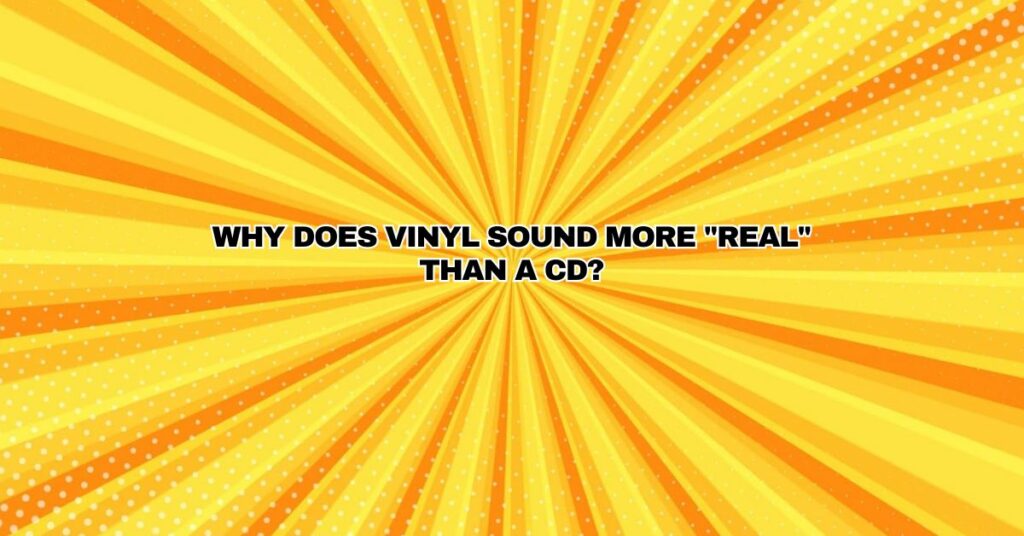In the realm of audio reproduction, the debate between vinyl records and compact discs (CDs) has been a subject of fascination and contention for audiophiles and music lovers alike. One argument that consistently emerges in favor of vinyl is that it sounds more “real” or authentic compared to CDs. But what exactly accounts for this perception, and why do some people find vinyl’s analog warmth and character so compelling? In this comprehensive article, we will explore the factors that contribute to the unique, “real” sound of vinyl records and examine the technical and subjective aspects that make vinyl a cherished medium for music playback.
1. Analog vs. Digital: The Fundamental Difference:
The primary distinction between vinyl and CD audio lies in the nature of the recording and playback processes. Vinyl records are analog, while CDs are digital.
- Vinyl Records: Vinyl records are analog recordings, which means that the sound is represented by physical variations in the grooves etched onto the vinyl surface. These grooves are a continuous, unbroken representation of the sound wave, and the stylus reads these grooves in real-time to reproduce the sound.
- Compact Discs: CDs, on the other hand, use digital audio encoding. The sound is sampled at specific intervals and converted into a digital code, which is then stored on the disc. CD playback involves reassembling these digital codes into an analog signal that can be sent to speakers.
2. Analog Warmth and Character:
One of the reasons vinyl records are often described as sounding more “real” is the analog warmth and character they introduce to the music. This warmth is due to several factors:
- Vinyl Grooves: The physical grooves on a vinyl record can capture a wide range of subtle details and nuances in the music that might be smoothed over or lost in the digitization process of CD audio.
- Surface Noise: Vinyl records can introduce a gentle layer of surface noise, including soft pops and crackles. While some might view this as a drawback, it’s also part of the analog charm, contributing to the perception of authenticity.
- Dynamic Range: Vinyl records often have a broader dynamic range, allowing for more pronounced differences between quiet and loud parts of a song. This dynamic range can create a more immersive and lifelike listening experience.
3. Mastering and Pressing Quality:
The sound quality of vinyl records also depends on the mastering and pressing quality. Mastering for vinyl involves optimizing the audio for the analog format, adjusting for factors like groove spacing, stylus movement, and dynamic range. A well-mastered vinyl record can result in a more natural and authentic sound.
Pressing quality is another critical factor. High-quality vinyl pressings with low surface noise and minimal distortion contribute to the overall “realness” of the sound.
4. Subjectivity and Nostalgia:
Music appreciation is highly subjective. Listeners who grew up with vinyl records may associate the format with nostalgic memories, which can enhance the perception of authenticity and emotional connection. The ritual of handling vinyl, selecting records, and carefully placing the needle on the groove can also contribute to the sense of “realness” for many.
5. Vinyl as a Tangible Experience:
The physicality of vinyl records adds to the perception of authenticity. The tactile experience of handling records, reading album covers, and placing the stylus on the record can make the listening process feel more personal and real.
6. Vinyl’s Limitations:
It’s essential to recognize that while vinyl records have unique qualities that some find appealing, they also have limitations. Vinyl is susceptible to wear and tear, and records can be easily scratched or damaged. They are also more sensitive to external factors such as dust and temperature variations, which can impact sound quality.
In Conclusion:
The perception that vinyl records sound more “real” than CDs is rooted in the analog nature of vinyl, the warmth and character it introduces, the mastering and pressing quality, and the subjective elements of nostalgia and tactile engagement. While the preference for vinyl or digital audio is a matter of personal taste, there’s no denying that vinyl records offer a distinct and authentic listening experience that continues to captivate audiophiles and music enthusiasts worldwide. Whether you’re drawn to the nostalgic charm, the warmth of analog sound, or the tangible experience, vinyl records offer a unique and cherished way to connect with music.


